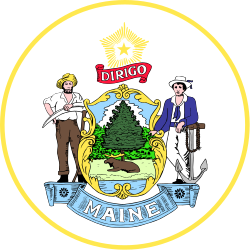| | ||||||||||||||||||||||||||
| ||||||||||||||||||||||||||
| ||||||||||||||||||||||||||
 County Results
| ||||||||||||||||||||||||||
| ||||||||||||||||||||||||||
| Elections in Maine |
|---|
 |
A presidential election was held in Maine on November 2, 1840 as part of the 1840 United States presidential election. [1] Voters chose ten representatives, or electors to the Electoral College, who voted for president and vice president.
Contents
Maine voted for the Whig candidate, William Henry Harrison, over Democratic candidate Martin Van Buren. Harrison won the state by a very narrow margin of 0.46%.
Maine was typically a Democratic state during the Second Party System, however, with Harrison narrowly winning the state, this would be the only time that a Whig presidential candidate would win Maine.


